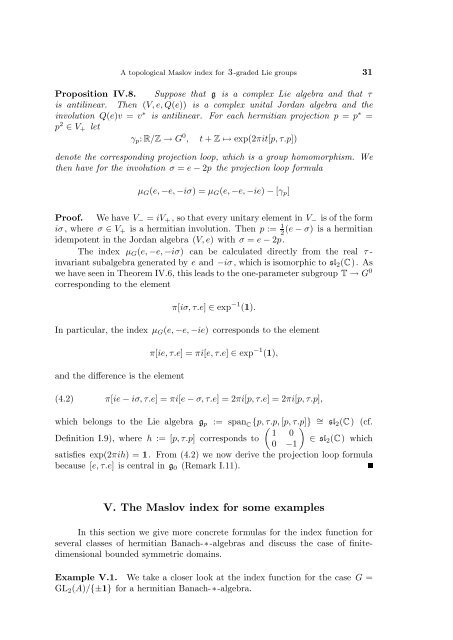A topological Maslov index for 3-graded Lie groups - ResearchGate
A topological Maslov index for 3-graded Lie groups - ResearchGate
A topological Maslov index for 3-graded Lie groups - ResearchGate
You also want an ePaper? Increase the reach of your titles
YUMPU automatically turns print PDFs into web optimized ePapers that Google loves.
A <strong>topological</strong> <strong>Maslov</strong> <strong>index</strong> <strong>for</strong> 3-<strong>graded</strong> <strong>Lie</strong> <strong>groups</strong> 31<br />
Proposition IV.8. Suppose that g is a complex <strong>Lie</strong> algebra and that τ<br />
is antilinear. Then (V, e, Q(e)) is a complex unital Jordan algebra and the<br />
involution Q(e)v = v ∗ is antilinear. For each hermitian projection p = p ∗ =<br />
p 2 ∈ V+ let<br />
γp: R/Z → G 0 , t + Z ↦→ exp(2πit[p, τ.p])<br />
denote the corresponding projection loop, which is a group homomorphism. We<br />
then have <strong>for</strong> the involution σ = e − 2p the projection loop <strong>for</strong>mula<br />
µG(e, −e, −iσ) = µG(e, −e, −ie) − [γp]<br />
Proof. We have V− = iV+, so that every unitary element in V− is of the <strong>for</strong>m<br />
iσ, where σ ∈ V+ is a hermitian involution. Then p := 1<br />
2 (e − σ) is a hermitian<br />
idempotent in the Jordan algebra (V, e) with σ = e − 2p.<br />
The <strong>index</strong> µG(e, −e, −iσ) can be calculated directly from the real τ -<br />
invariant subalgebra generated by e and −iσ, which is isomorphic to sl2(C). As<br />
we have seen in Theorem IV.6, this leads to the one-parameter subgroup T → G0 corresponding to the element<br />
π[iσ, τ.e] ∈ exp −1 (1).<br />
In particular, the <strong>index</strong> µG(e, −e, −ie) corresponds to the element<br />
and the difference is the element<br />
π[ie, τ.e] = πi[e, τ.e] ∈ exp −1 (1),<br />
(4.2) π[ie − iσ, τ.e] = πi[e − σ, τ.e] = 2πi[p, τ.e] = 2πi[p, τ.p],<br />
which belongs to the <strong>Lie</strong> algebra gp := spanC {p, τ.p, [p, τ.p]} ∼ = sl2(C) (cf.<br />
1 0<br />
Definition I.9), where h := [p, τ.p] corresponds to<br />
∈ sl2(C) which<br />
0 −1<br />
satisfies exp(2πih) = 1. From (4.2) we now derive the projection loop <strong>for</strong>mula<br />
because [e, τ.e] is central in g0 (Remark I.11).<br />
V. The <strong>Maslov</strong> <strong>index</strong> <strong>for</strong> some examples<br />
In this section we give more concrete <strong>for</strong>mulas <strong>for</strong> the <strong>index</strong> function <strong>for</strong><br />
several classes of hermitian Banach-∗-algebras and discuss the case of finitedimensional<br />
bounded symmetric domains.<br />
Example V.1. We take a closer look at the <strong>index</strong> function <strong>for</strong> the case G =<br />
GL2(A)/{±1} <strong>for</strong> a hermitian Banach-∗-algebra.

















